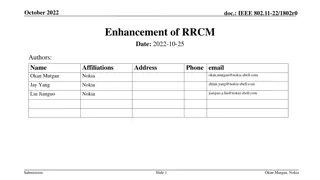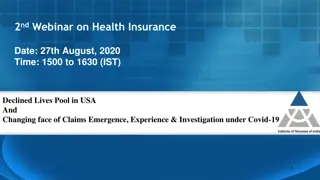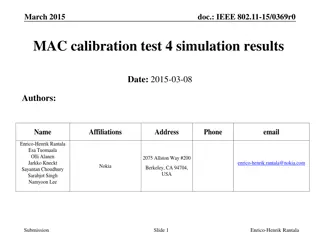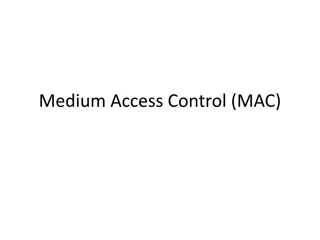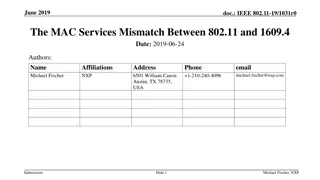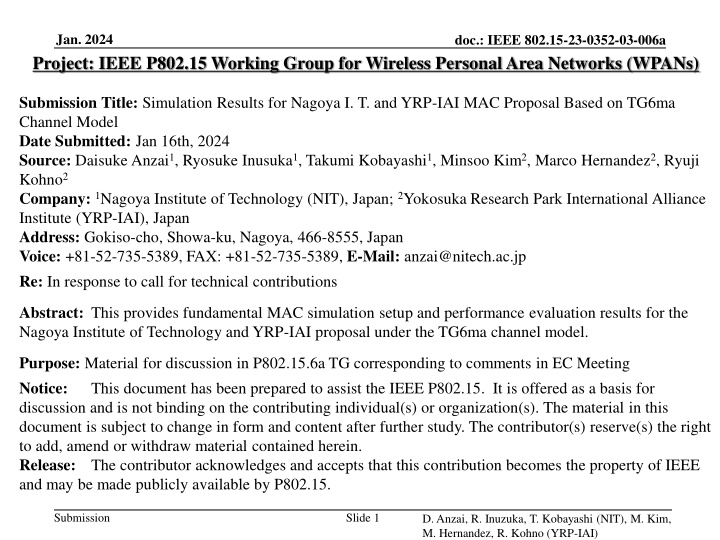
Simulation Results for Nagoya I. T. and YRP-IAI MAC Proposal Based on TG6ma Channel Model
Explore fundamental MAC simulation setup and performance evaluation results for the Nagoya Institute of Technology and YRP-IAI proposal under the TG6ma channel model. The document presents a structured approach to manage the coexistence of multiple Body Area Networks (BANs) and Ultra-Wideband (UWB) applications, focusing on optimized control and avoidance of packet collisions. Dive into the significance of the proposed synchronous superframe structure in ensuring high dependability in complex BAN coexistence scenarios.
Download Presentation

Please find below an Image/Link to download the presentation.
The content on the website is provided AS IS for your information and personal use only. It may not be sold, licensed, or shared on other websites without obtaining consent from the author. If you encounter any issues during the download, it is possible that the publisher has removed the file from their server.
You are allowed to download the files provided on this website for personal or commercial use, subject to the condition that they are used lawfully. All files are the property of their respective owners.
The content on the website is provided AS IS for your information and personal use only. It may not be sold, licensed, or shared on other websites without obtaining consent from the author.
E N D
Presentation Transcript
Jan. 2024 Project: IEEE P802.15 Working Group for Wireless Personal Area Networks (WPANs) doc.: IEEE 802.15-23-0352-03-006a Submission Title: Simulation Results for Nagoya I. T. and YRP-IAI MAC Proposal Based on TG6ma Channel Model Date Submitted: Jan 16th, 2024 Source: Daisuke Anzai1, Ryosuke Inusuka1, Takumi Kobayashi1, Minsoo Kim2, Marco Hernandez2, Ryuji Kohno2 Company:1Nagoya Institute of Technology (NIT), Japan; 2Yokosuka Research Park International Alliance Institute (YRP-IAI), Japan Address: Gokiso-cho, Showa-ku, Nagoya, 466-8555, Japan Voice: +81-52-735-5389, FAX: +81-52-735-5389, E-Mail: anzai@nitech.ac.jp Re: In response to call for technical contributions Abstract: This provides fundamental MAC simulation setup and performance evaluation results for the Nagoya Institute of Technology and YRP-IAI proposal under the TG6ma channel model. Purpose: Material for discussion in P802.15.6a TG corresponding to comments in EC Meeting Notice: This document has been prepared to assist the IEEE P802.15. It is offered as a basis for discussion and is not binding on the contributing individual(s) or organization(s). The material in this document is subject to change in form and content after further study. The contributor(s) reserve(s) the right to add, amend or withdraw material contained herein. Release: The contributor acknowledges and accepts that this contribution becomes the property of IEEE and may be made publicly available by P802.15. Submission Slide 1 D. Anzai, R. Inuzuka, T. Kobayashi (NIT), M. Kim, M. Hernandez, R. Kohno (YRP-IAI)
Jan. 2024 doc.: IEEE 802.15-23-0352-03-006a Simulation Results for Nagoya I. T. and YRP- IAI MAC Proposal Based on TG6ma Channel Model Daisuke Anzai, Ryosuke Inuzuka, Takumi Kobayashi Minsoo Kim, Marco Hernandez, and Ryuji Kohno Nagoya Institute of Technology (NIT), YRP International Alliance Institute (YRP-IAI) Submission Slide 2 D. Anzai, R. Inuzuka, T. Kobayashi (NIT), M. Kim, M. Hernandez, R. Kohno (YRP-IAI)
Jan. 2024 doc.: IEEE 802.15-23-0352-03-006a Introduction Coexistence of multiple BANs and other UWB applications (e.g. IEEE 802.15.4ab) is a key issue in providing high dependability In multiple BAN coexistence, we propose a managed synchronous superframe structure to avoid packet collisions even between different BANs, which is optimally controlled under multiple BAN coexistence situations We carry out fundamental MAC performance evaluation to demonstrate the importance of the proposed structure based on the TG6ma channel model with IR-UWB modulation Submission Slide 3 D. Anzai, R. Inuzuka, T. Kobayashi (NIT), M. Kim, M. Hernandez, R. Kohno (YRP-IAI)
Jan. 2024 Proposal of managed synchronous superframe doc.: IEEE 802.15-23-0352-03-006a Asynchronous superfrace Network Management Contention Free Period Contention Access Period Inactive Period BAN1 time !! !" Collision Collision GAP BAN2 time !! !" Synchronous superframe Network Management Contention Free Period Contention Access Period Inactive Period BAN1 time !! No GAP !! Collision Collision BAN2 time !! !! Unified superframce Managed synchronous superframe Normal packet (BAN1) Normal packet (BAN2) Contention Free Period Timeslot assignment perfectly controlled Network Management Contention Access Period Inactive Period in TDMA (CFP) BAN time D-Beacon (BAN1) No Collision No Collision D-Beacon (BAN2) !! Submission Slide 4 D. Anzai, R. Inuzuka, T. Kobayashi (NIT), M. Kim, M. Hernandez, R. Kohno (YRP-IAI)
Jan. 2024 doc.: IEEE 802.15-23-0352-03-006a Antenna pattern We confirmed that the antenna gain was degraded to -20 dBi, compared with 4 dBi in free space Submission Slide 5 D. Anzai, R. Inuzuka, T. Kobayashi (NIT), M. Kim, M. Hernandez, R. Kohno (YRP-IAI)
Jan. 2024 doc.: IEEE 802.15-23-0352-03-006a MAC evaluation simulation setup Head 102 Neck 220 Arm 540 Arm 540 Torso 590 Distance [mm] Pathloss [dB] Human body Pathloss Free space 43.3 42.9 49.1 49.1 56.0 A B C D 22.4- 26.4 9.5 4.70 1.66 20 29.1-33.1 36.9-40.9 36.9-40.9 37.7-41.7 173 cm : Hub : Node PL0 [dB] n d0 (mm) 16.5 2.52 0.69 20 36.3 1.75 0.18 100 36.3 1.75 0.18 100 26.3 3.85 0.067 100 A: Head B: Neck C: Arm D: Torso BAN 1 Here, the antenna gain was modified based on the FDTD calculation results d d d BAN 2 BAN 3 Submission Slide 6 D. Anzai, R. Inuzuka, T. Kobayashi (NIT), M. Kim, M. Hernandez, R. Kohno (YRP-IAI)
Jan. 2024 doc.: IEEE 802.15-23-0352-03-006a MAC simulation parameters Network Management Contention Free Contention Access Inactive D-Beacon time 4 ms Modulation scheme IR-UWB OOK ?? 40 s Number of BANs 2, 3 ?? Number of super frames 500 Number of nodes in each BAN 4 Number of timeslots 100 Max number of retransmissions 5 Network management 5 ARQ protocol Stop-and-Wait Contention free period 60 timeslot Max waiting timeslot (CAP) 10 Contention access period 30 timeslot Packet generation distribution Poisson Inactive period 5 timeslot Data rate 50 Mbps GAP 0-99 timeslot Packet length 2000 bit Submission Slide 7 D. Anzai, R. Inuzuka, T. Kobayashi (NIT), M. Kim, M. Hernandez, R. Kohno (YRP-IAI)
Jan. 2024 doc.: IEEE 802.15-23-0352-03-006a Evaluation results in CFP for managed synchronous superframe Submission Slide 8 D. Anzai, R. Inuzuka, T. Kobayashi (NIT), M. Kim, M. Hernandez, R. Kohno (YRP-IAI)
Jan. 2024 doc.: IEEE 802.15-23-0352-03-006a Evaluation results in CFP for managed synchronous superframe Submission Slide 9 D. Anzai, R. Inuzuka, T. Kobayashi (NIT), M. Kim, M. Hernandez, R. Kohno (YRP-IAI)
Jan. 2024 doc.: IEEE 802.15-23-0352-03-006a References 1. D. Anzai, R. Inuzuka, M. Kim, T. Kobayashi, M. Hernandez, R. Kohno, Fundamental MAC Performance Evaluation under Multiple IEEE802.15.6ma BAN Co-Existence, in Proc. IEEE ISMICT 2023, Lincoln, USA, Mach 2023. D. Anzai, I. Balasingham, G. Fischer, J. Wang, Reliable and High-Speed Implant Ultra-Wideband Communications with EAI/Springer Innovations in Communication and Computing, pp. 27-32, March 2020. Y. Shimizu, D. Anzai, R. C-Santiago, P. A. Floor, I. Balasingham, and J. Wang, Performance evaluation of an ultra-wideband transmit diversity in a living animal experiment IEEE Trans. Microw. Theory Tech., vol. 65, no. 7, pp. 2596- 2606, July 2017. D. Anzai, K. Katsu, R. Chavez-Santiago, Q. Wang, D. Plettemeier, J. Wang, and I. Balasingham, Experimental evaluation of implant UWB-IR transmission with living animal for body area networks, IEEE Trans. Microw. Theory Tech., vol. 62, no. 1, pp. 183-192, Jan. 2014. J. Shi, D. Anzai, and J. Wang, Channel modeling and performance analysis of diversity reception for implant UWB wireless link, IEICE Trans. Commun., no. E95-B, vol. 10, pp. 3197-3205, Oct. 2012. 2. Transmit Receive Diversity, 3. 4. 5. Submission Slide 10 D. Anzai, R. Inuzuka, T. Kobayashi (NIT), M. Kim, M. Hernandez, R. Kohno (YRP-IAI)
















